Input interpretation

perchloric acid
Physical properties

vapor pressure | 2.027 kPa (kilopascals)
Solution properties
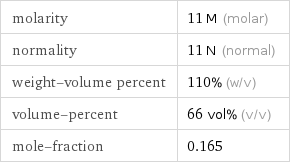
molarity | 11 M (molar) normality | 11 N (normal) weight-volume percent | 110% (w/v) volume-percent | 66 vol% (v/v) mole-fraction | 0.165
Solute properties per 100 mL
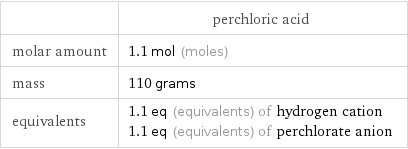
| perchloric acid molar amount | 1.1 mol (moles) mass | 110 grams equivalents | 1.1 eq (equivalents) of hydrogen cation 1.1 eq (equivalents) of perchlorate anion
Acid-base information
![K_a | 1.00×10^10 pK_a | -10.0 pH | -1.04 [H_3O^+] | 11 mol/L (moles per liter) pOH | 15.0 [OH^-] | 9.09×10^-16 mol/L (moles per liter) % ionization | 100%](../image_source/f4f91688c42e9e52d45c2d3681361ff0.png)
K_a | 1.00×10^10 pK_a | -10.0 pH | -1.04 [H_3O^+] | 11 mol/L (moles per liter) pOH | 15.0 [OH^-] | 9.09×10^-16 mol/L (moles per liter) % ionization | 100%
Lewis structure
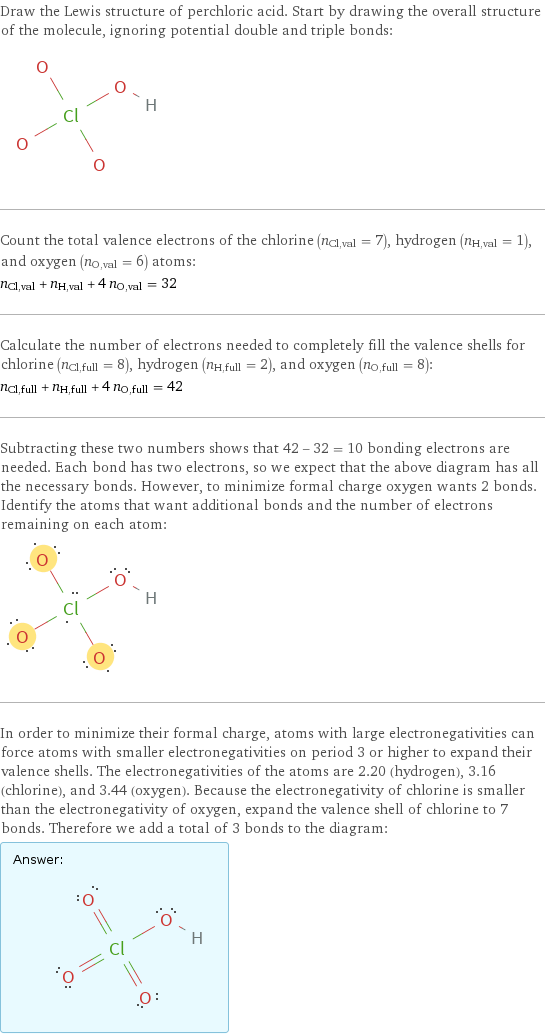
Draw the Lewis structure of perchloric acid. Start by drawing the overall structure of the molecule, ignoring potential double and triple bonds: Count the total valence electrons of the chlorine (n_Cl, val = 7), hydrogen (n_H, val = 1), and oxygen (n_O, val = 6) atoms: n_Cl, val + n_H, val + 4 n_O, val = 32 Calculate the number of electrons needed to completely fill the valence shells for chlorine (n_Cl, full = 8), hydrogen (n_H, full = 2), and oxygen (n_O, full = 8): n_Cl, full + n_H, full + 4 n_O, full = 42 Subtracting these two numbers shows that 42 - 32 = 10 bonding electrons are needed. Each bond has two electrons, so we expect that the above diagram has all the necessary bonds. However, to minimize formal charge oxygen wants 2 bonds. Identify the atoms that want additional bonds and the number of electrons remaining on each atom: In order to minimize their formal charge, atoms with large electronegativities can force atoms with smaller electronegativities on period 3 or higher to expand their valence shells. The electronegativities of the atoms are 2.20 (hydrogen), 3.16 (chlorine), and 3.44 (oxygen). Because the electronegativity of chlorine is smaller than the electronegativity of oxygen, expand the valence shell of chlorine to 7 bonds. Therefore we add a total of 3 bonds to the diagram: Answer: | |
Chemical names and formulas
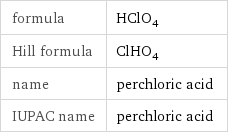
formula | HClO_4 Hill formula | ClHO_4 name | perchloric acid IUPAC name | perchloric acid
Substance properties
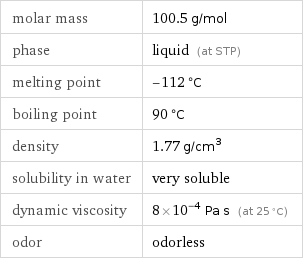
molar mass | 100.5 g/mol phase | liquid (at STP) melting point | -112 °C boiling point | 90 °C density | 1.77 g/cm^3 solubility in water | very soluble dynamic viscosity | 8×10^-4 Pa s (at 25 °C) odor | odorless
Units
